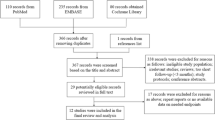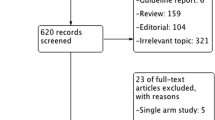Abstract
Background
Interatrial septum (IAS) pacing seems to be a promising strategy for the prevention of atrial fibrillation (AF); however, studies have yielded conflicting results. This meta-analysis was to compare IAS with right atrial appendage (RAA) pacing on the prevention of postpacing AF occurrence.
Methods
Pubmed, MEDLINE, EMBASE and Web of Science databases were searched through October 2016 for randomized controlled trials comparing IAS with RAA pacing on the prevention of AF. Data concerning study design, patient characteristics and outcomes were extracted. Risk ratio (RR), weighted mean differences (WMD) or standardized mean differences (SMD) were calculated using fixed or random effects models.
Results
A total of 12 trials involving 1146 patients with dual-chamber pacing were included. Although IAS was superior to RAA pacing in terms of reducing the number of AF episodes (SMD = −0.29, P = 0.05), AF burden (SMD = −0.41, P = 0.008) and P -wave duration (WMD = −34.45 ms, P < 0.0001), neither permanent AF occurrence (RR = 0.94, P = 0.58) nor recurrences of AF (RR = 0.88, P = 0.36) were reduced by IAS pacing. Nevertheless, no differences were observed concerning all-cause death (RR = 1.04, P = 0.88), procedure-related events (RR = 1.17, P = 0.69) and pacing parameters between IAS and RAA pacing in the follow-up period.
Conclusions
IAS pacing is safe and as well tolerated as RAA pacing. Although IAS pacing may fail to prevent permanent AF occurrence and recurrences of AF, it is able to not only improve interatrial conduction, but also reduce AF burden.
Zusammenfassung
Hintergrund
Die Schrittmacherstimulation am Vorhofseptum (VHS) scheint ein vielversprechender Ansatz zur Prävention von Vorhofflimmern („atrial fibrillation“ [AF]) zu sein. Die vorliegenden Studienergebnisse sind allerdings widersprüchlich. In der vorliegenden Metaanalyse sollte die Stimulation des VHS mit der des rechten Herzohrs (RHO) bezüglich der Prävention von AF-Ereignissen nach Schrittmacherstimulation verglichen werden.
Methoden
Die Datenbanken PubMed, MEDLINE, EMBASE und Web of Science wurden bis Oktober 2016 nach randomisierten, kontrollierten Studien durchsucht, welche die VHS- und RHO-Stimulation mit Blick auf die AF-Prävention verglichen. Daten zu Studiendesign, Patientencharakteristika und Ergebnissen wurden extrahiert. Das relative Risiko (RR), die gewichteten Mittelwertdifferenzen („weighted mean differences“ [WMD]) oder die standardisierten Mittelwertdifferenzen (SMD) wurden mit Fixed- oder Random-effects-Modellen berechnet.
Ergebnisse
Es wurden 12 Studien eingeschlossen, die 1146 Patienten mit 2‑Kammer-Stimulation umfassten. Obwohl die VHS- der RHO-Stimulation in Bezug auf die Reduktion der AF-Episoden-Zahl (SMD = −0,29, p = 0,05), die AF-bedingte Belastung (SMD = −0,41, p = 0,008) und die P‑Wellen-Dauer (WMD = −34,45 ms, p < 0,0001) überlegen war, verringerte sie weder das Auftreten von permanentem AF (RR = 0,94, p = 0,58) noch AF-Rezidive (RR = 0,88, p = 0,36). Dennoch wurden zwischen der VHS- und RHO-Stimulation über die Dauer des Follow-ups keine Unterschiede in den Sterbefällen insgesamt (RR = 1,04, p = 0,88), den eingriffsbezogenen Ereignissen (RR = 1,17, p = 0,69) und den Stimulationsparametern beobachtet.
Schlussfolgerungen
Die VHS-Stimulation ist sicher und wird so gut vertragen wie die RHO-Stimulation. Auch wenn es mit der VHS-Stimulation vielleicht nicht gelingt, permanentes AF und AF-Rezidive zu vermeiden, kann sie doch die interatriale Erregungsleitung verbessern und könnte zudem die AF-bedingte Belastung senken.





Similar content being viewed by others
References
Rahman F, Kwan GF, Benjamin EJ (2014) Global epidemiology of atrial fibrillation. Nat Rev Cardiol 11:639–654
Chugh SS, Havmoeller R, Narayanan K et al (2014) Worldwide epidemiology of atrial fibrillation: a Global Burden of Disease 2010 Study. Circulation 129:837–847
Prystowsky EN, Padanilam BJ, Fogel RI (2015) Treatment of atrial fibrillation. JAMA 314:278–288
Kyprianou K, Pericleous A, Stavrou A, Dimitrakaki IA, Challoumas D, Dimitrakakis G (2016) Surgical perspectives in the management of atrial fibrillation. World J Cardiol 8:41–56
Padeletti L, Michelucci A, Pieragnoli P, Colella A, Musilli N (2004) Atrial septal pacing: a new approach to prevent atrial fibrillation. Pacing Clin Electrophysiol 27:850–854
Healey JS, Israel CW, Connolly SJ et al (2012) Relevance of electrical remodeling in human atrial fibrillation: results of the Asymptomatic Atrial Fibrillation and Stroke Evaluation in Pacemaker Patients and the Atrial Fibrillation Reduction Atrial Pacing Trial mechanisms of atrial fibrillation study. Circ Arrhythm Electrophysiol 5:626–631
Buxton AE, Josephson ME (1981) The role of P wave duration as a predictor of postoperative atrial arrhythmias. Chest 80:68–73
Stabile G, Senatore G, De Simone A et al (1999) Determinants of efficacy of atrial pacing in preventing atrial fibrillation recurrences. J Cardiovasc Electrophysiol 10:2–9
Padeletti L, Porciani MC, Michelucci A et al (1999) Interatrial septum pacing: a new approach to prevent recurrent atrial fibrillation. J Interv Card Electrophysiol 3:35–43
Yamada T, Fukunami M, Shimonagata T et al (2001) Effect of atrial septal pacing on P‑wave duration dispersion and atrial late potentials in patients with paroxysmal atrial fibrillation. Am J Cardiol 88:795–798
Bailin SJ, Adler S, Giudici M (2001) Prevention of chronic atrial fibrillation by pacing in the region of Bachmann’s bundle: results of a multicenter randomized trial. J Cardiovasc Electrophysiol 12:912–917
Lau CP, Tachapong N, Wang CC et al (2013) Prospective randomized study to assess the efficacy of site and rate of atrial pacing on long-term progression of atrial fibrillation in sick sinus syndrome: Septal Pacing for Atrial Fibrillation Suppression Evaluation (SAFE) Study. Circulation 128:687–693
Nigro G, Russo V, Politano L et al (2010) Does Bachmann’s bundle pacing prevent atrial fibrillation in myotonic dystrophy type 1 patients? A 12 months follow-up study. Europace 12:1219–1223
Spitzer SG, Wacker P, Gazarek S, Malinowski K, Schibgilla V (2009) Primary prevention of atrial fibrillation: does the atrial lead position influence the incidence of atrial arrhythmias in patients with sinus node dysfunction? Results from the PASTA Trial. Pacing Clin Electrophysiol 32:1553–1561
Verlato R, Botto GL, Massa R et al (2011) Efficacy of low interatrial septum and right atrial appendage pacing for prevention of permanent atrial fibrillation in patients with sinus node disease: results from the electrophysiology-guided pacing site selection (EPASS) study. Circ Arrhythm Electrophysiol 4:844–850
Hakacova N, Velimirovic D, Margitfalvi P, Hatala R, Buckingham TA (2007) Septal atrial pacing for the prevention of atrial fibrillation. Europace 9:1124–1128
Hermida JS, Carpentier C, Kubala M et al (2003) Atrial septal versus atrial appendage pacing: feasibility and effects on atrial conduction, interatrial synchronization, and atrioventricular sequence. Pacing Clin Electrophysiol 26:26–35
Hermida JS, Kubala M, Lescure FX et al (2004) Atrial septal pacing to prevent atrial fibrillation in patients with sinus node dysfunction: results of a randomized controlled study. Am Heart J 148:312–317
Padeletti L, Botto G, Spampinato A et al (2003) Prevention of paroxysmal atrial fibrillation in patients with sinus bradycardia: role of right atrial linear ablation and pacing site. J Cardiovasc Electrophysiol 14:733–738
Padeletti L, Gasparini M, Proclemer A et al (2001) Progression to permanent atrial fibrillation following AV node ablation and DDD-R pacemaker implantation is affected by the atrial pacing site. J Am Coll Cardiol 37:94A–94A
Padeletti L, Pieragnoli P, Ciapetti C et al (2001) Randomized crossover comparison of right atrial appendage pacing versus interatrial septum pacing for prevention of paroxysmal atrial fibrillation in patients with sinus bradycardia. Am Heart J 142:1047–1055
Verlato R, Zanon F, Bertaglia E et al (2007) Prevalence of conduction delay of the right atrium in patients with SSS: implications for pacing site selection. J Cardiovasc Med (Hagerstown) 8:706–712
Benjamin EJ, Wolf PA, D’Agostino RB, Silbershatz H, Kannel WB, Levy D (1998) Impact of atrial fibrillation on the risk of death: the Framingham Heart Study. Circulation 98:946–952
Sgarbossa EB, Pinski SL, Maloney JD et al (1993) Chronic atrial fibrillation and stroke in paced patients with sick sinus syndrome. Relevance of clinical characteristics and pacing modalities. Circulation 88:1045–1053
Glotzer TV, Hellkamp AS, Zimmerman J et al (2003) Atrial high rate episodes detected by pacemaker diagnostics predict death and stroke: report of the Atrial Diagnostics Ancillary Study of the MOde Selection Trial (MOST). Circulation 107:1614–1619
Kochhäuser S, Joza J, Essebag V et al (2016) The Impact of duration of atrial fibrillation recurrences on measures of health-related quality of life and symptoms. Pacing Clin Electrophysiol 39:166–172
Funck RC, Pomsel K, Grimm W, Hufnagel G, Maisch B (2001) Prevention of atrial arrhythmias by pacing. Herz 26:18–29
Yu WC, Tsai CF, Hsieh MH et al (2000) Prevention of the initiation of atrial fibrillation: mechanism and efficacy of different atrial pacing modes. Pacing Clin Electrophysiol 23:373–379
Dabrowska-Kugacka A, Lewicka-Nowak E, Rucinski P, Zagozdzon P, Raczak G, Kutarski A (2009) Atrial electromechanical sequence and contraction synchrony during single- and multisite atrial pacing in patients with brady-tachycardia syndrome. Pacing Clin Electrophysiol 32:591–603
Slawuta A, Skoczynski P, Bankowski T, Klis M, Gajek J (2013) Bachmann’s bundle pacing not only improves interatrial conduction but also reduces the need for ventricular pacing. Eur Heart J 34(suppl 1):2619
Inoue N, Ishikawa T, Sumita S et al (2006) Suppression of atrial fibrillation by atrial pacing. Circ J 70:1398–1401
Abu-El-Haija B, Giudici MC (2014) Predictors of long-term maintenance of normal sinus rhythm after successful electrical cardioversion. Clin Cardiol 37:381–385
Costa FM, Ferreira AM, Oliveira S et al (2015) Left atrial volume is more important than the type of atrial fibrillation in predicting the long-term success of catheter ablation. Int J Cardiol 184:56–61
Klis M, Slawuta A, Gajek J (2015) Antiarrhythmic properties of atrial pacing – Alternative sites or better pharmacotherapy or both? Int J Cardiol 184:294–295
Gillis AM, Wyse DG, Connolly SJ et al (1999) Atrial pacing periablation for prevention of paroxysmal atrial fibrillation. Circulation 99:2553–2558
Niwano S, Yamaura M, Washizuka T et al (1998) Comparison of arrhythmogenicity of atrial pacing at several right atrial pacing sites: evaluation of canine atrial electrograms during atrial pacing and arrhythmogenicity for atrial fibrillation. Pacing Clin Electrophysiol 21:1918–1926
Prakash A, Saksena S, Hill M et al (1997) Acute effects of dual-site right atrial pacing in patients with spontaneous and inducible atrial flutter and fibrillation. J Am Coll Cardiol 29:1007–1014
Saksena S, Prakash A, Ziegler P et al (2002) Improved suppression of recurrent atrial fibrillation with dual-site right atrial pacing and antiarrhythmic drug therapy. J Am Coll Cardiol 40:1140–1150
D’Allonnes GR, Pavin D, Leclercq C et al (2000) Long-term effects of biatrial synchronous pacing to prevent drug-refractory atrial tachyarrhythmia: a nine-year experience. J Cardiovasc Electrophysiol 11:1081–1091
Cooper JM, Katcher MS, Orlov MV (2002) Implantable devices for the treatment of atrial fibrillation. N Engl J Med 346:2062–2068
Sulke N, Silberbauer J, Boodhoo L et al (2007) The use of atrial overdrive and ventricular rate stabilization pacing algorithms for the prevention and treatment of paroxysmal atrial fibrillation: the Pacemaker Atrial Fibrillation Suppression (PAFS) study. Europace 9:790–797
Funding
This study was supported by the National Natural Science Foundation of China (No. 81400193 and 81671934) and the Specialized Research Fund for the Doctoral Program of Higher Education (No. 20130071120100).
Author information
Authors and Affiliations
Corresponding authors
Ethics declarations
Conflict of interest
L. Zhang, H. Jiang, W. Wang, J. Bai, Y. Liang, Y. Su and J. Ge declare that they have no conflicts of interest.
This article does not contain any studies with human participants or animals performed by any of the authors.
Additional information
Drs Lei Zhang and Hong Jiang contributed equally to this work.
Caption Electronic Supplementary Material
59_2017_4589_MOESM1_ESM.doc
Supplement. Fig. 1 Publication bias. (a) Egger’s test (linear regression) and (b) Begg’s funnel plot for permanent atrial fibrillation occurrence. RR risk ratio
Rights and permissions
About this article
Cite this article
Zhang, L., Jiang, H., Wang, W. et al. Interatrial septum versus right atrial appendage pacing for prevention of atrial fibrillation . Herz 43, 438–446 (2018). https://doi.org/10.1007/s00059-017-4589-7
Received:
Revised:
Accepted:
Published:
Issue Date:
DOI: https://doi.org/10.1007/s00059-017-4589-7
Keywords
- Atrial fibrillation
- Interatrial septum pacing
- Right atrial appendage pacing
- Meta-analysis
- Pacemaker population




